
The Independent Communications Authority of SA (ICASA) has published the final regulations on the use of TV white space (TVWS), but commercial deployment of this technology is still unknown.
In a statement, the Dynamic Spectrum Alliance (DSA) lauded the South African regulating authority for its efforts concerning TVWS regulations, adding it looks forward to ICASA taking the necessary steps in the commercial deployment of this technology.
African nations have over the years been criticised by advocates of TVWS frequencies for under-utilising the technology that can improve Internet access on the continent.
The DSA, a global organisation advocating for laws and regulations for efficient and effective spectrum utilisation, says ICASA's regulations highlight the progress in the adoption of TVWS and mark a huge step in SA enabling affordable broadband through dynamic spectrum access technologies.
Successful trials
Television white spaces refer to unused frequencies in the wireless spectrum between TV broadcasts that can be utilised to provide broadband. This will increase once SA finally migrates from analogue to digital terrestrial television.
Many TVWS projects for commercial applications are operational around the world to deliver connectivity to those that are difficult to reach. In SA, Google, Microsoft, the Council for Scientific and Industrial Research, as well as the Wireless Access Providers Association, have in the past led successful TV white spaces trials.
Despite this, operational processes to enable commercial use of this technology have been non-existent.
Last year, ICASA co-hosted the DSA Global Summit in Cape Town to discuss the progress SA is making in enabling affordable Internet through dynamic spectrum access.
The country's regulating authority notes that one of the purposes of the TVWS regulations is to support the uptake of affordable broadband services and access by the under-served.
Kalpak Gude, president of the DSA, says TV white space technology provides an alternative but complementary ecosystem to LTE technologies for bridging the digital divide and inexpensively delivering broadband.
"The DSA is excited that TVWS regulations are being considered in a number of other countries in Africa, including Botswana, Ghana, Kenya, Malawi, Nigeria, Mozambique and Tanzania, and we believe South Africa's actions will spur more regulators in the region and around the world to move rapidly."
Regulatory fit
ICT veteran and IITPSA programme consultant Adrian Schofield says a challenge in the potential use of white space spectrum will be trying to establish where the technology fits in to the Department of Telecommunications and Postal Services' policy and legislation; in particular, in relation to the proposed wholesale open access network.
"If, for example, an 8MHz channel is allocated to a TV broadcaster, can parts of that channel also be licensed to another user or users? As with many of the opportunities offered by innovation and advanced technology, the question is whether our legislators and regulators can facilitate access, rather than seek to limit access," he explains.
Schofield also points out the importance of the technology is that it provides spectrum for long-distance, affordable connection of WiFi service providers in rural areas to the backbone infrastructure.
While he is concerned the speed may be less than required for broadband services, this, he adds, can be overcome by using multiple channels in parallel.
"ICASA published the draft regulations in response to the trials that proved the potential benefits of the technology, to obtain feedback from the sector and provide a framework for controlled access to the available spectrum, which would otherwise be subject to interference from other users and poor signal quality."
Share